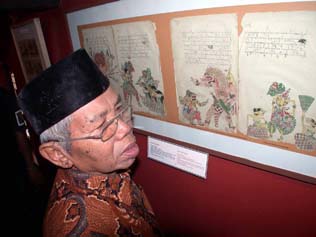Manuscript Exhibit at Sampoerna Gallery: Surabaya, East Java
 Legends in Java are steeped in mysticism. If you are visiting Surabaya at the moment then you will be able to see an excellent exhibition. The tale of Rahwana seeking Dewi Widowati is a fragment of a longer story contained in the Rama Sungging, an original picture manuscript now on display through May 13 at the House of Sampoerna Art Gallery in Surabaya as I.D. Nugroho writes.
Legends in Java are steeped in mysticism. If you are visiting Surabaya at the moment then you will be able to see an excellent exhibition. The tale of Rahwana seeking Dewi Widowati is a fragment of a longer story contained in the Rama Sungging, an original picture manuscript now on display through May 13 at the House of Sampoerna Art Gallery in Surabaya as I.D. Nugroho writes.
King Rahwana was so angry when he received the letter from Prabu Danaraja, the step-brother of Dewi Widowati, that he had the messenger, Goh Muka, killed.
Goh Muka died because the King of Alengka had been offended by the content of Danaraja’s letter, which advised Rahwana not to marry Dewi Widowati. In the meantime, Rahwana and his army were under attack by the Lokapala Kingdom — led by Danaraja himself.
Rahwana was not alone in his predicament, and was supported by his teacher, Subali.
Danaraja, who also felt threatened, asked for help from Wisnungkara, a scholar, and his uncle Kisrahwana.
War broke out and the world trembled. Rahwana and his troops successfully defeated the Lokapala Kingdom; Wisnungkara and Kisrahwana were killed, and King Danaraja was in retreat.
But at that moment, the god Batara Narada came down from Heaven, separated the armies, and stopped the war.
The god asked King Danaraja to accept defeat, and he agreed. The kingdom of Lokapala then had to submit to the authority of Rahwana.
Unfortunately Rahwana, a mythical gigantic demon with a terrifying face, couldn’t find Dewi Widowati, who had run away. Rahwana swore to keep looking for Dewi Widowati — who is also described as Dewi Sri, which can mean “a grain of rice”.
Rama Sungging is an important part of the heritage of Indonesian puppetry. Sungging is a story with pictures that tells of events that lead up to the Ramayana epic, and is usually known as the account of Rahwana’s activities in the Lokapala Kingdom.
There are three main strains in Rama Sungging that weave into the Ramayana, the great Hindu classic that provides the themes for much of Javanese literature and traditional performing arts.
The first story is about Cupu Manik Astagina, a sacred object that was given as a gift by the god Batara Surya to Dewi Windradi. In Cupu Manik Astagina are contained the true secrets of nature and heaven.
The second tale is from Jendra literature, a story about a war between the King of Lokapala, Prabu Danaraja, and his father, Begawan Wisrawa. The conflict was triggered by Wisrawa’s marriage to Dewi Sukesi, a girl who loved Prabu Danaraja.
The last story is about Rahwana’s search for Dewi Widowati.
The Rama Sungging manuscript currently on exhibit belongs to the Bentara Budaya cultural center in Yogyakarta. It is an important and highly valued historical document obtained from a book lover in Jakarta who wants to remain anonymous.
When the Rama Sungging was first received last year, it had not been well preserved. From research undertaken by the Bentara Budaya, it is estimated that the manuscript was written around the 18th century.
Some clues come from the paper, which has a logo showing a lion in a circle and uses a specific typeface. This has been identified as paper made by the Dutch during the 18th and 19th centuries.
The manuscript also contains words in the Javanese alphabet known as honocoroko alongside puppet pictures.
It’s believed that the Sanskrit writing and puppet pictures were made by a man of letters or a keraton (palace) official, as at that time, only the palace had access to the Dutch government that could have supplied the paper.
The style is different from another picture manuscript that is owned by the keraton, in that the Rama Sungging is more expressive.
The script differs from the usual way of writing Javanese where the lettering is round and sharp — a style particular to the palace. Instead, the formation of the letters are not symmetrical.
“From the shape of the letters and Sanskrit language used, this is an old manuscript,” said Surono, a member of the Indonesian Puppet Masters’ Association who was present at the exhibition opening.
“The pictures in the Rama Sungging manuscript show a type of puppet known as wayang purwa, or classical. Three characters are illustrated.
“For example, in the Cupu Manik Astagina story the puppet is shown with a body shape like that of a human being. However, in the other two stories the puppet figures appear very similar to those used in modern shadow puppetry. The body is elongated, and there are two different designs,” he pointed out.
“The way these pictures have been drawn is typical of the style found in East Java. Look at the shape of the mustache forming a circle, and the way part of the kris is located in front.”
While examining the clear and colorful pictures, Surono noted a pencil scratch. This discovery makes him a little anxious about the conservation of the Rama Sungging manuscript.
“During the period this manuscript was made, did pencils exist?” he asked.
I.D. Nugroho